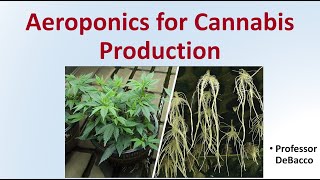Aeroponics for Cannabis Production
Aeroponics for Cannabis Production

Professor DeBacco
Aeroponics Basics
Plants are grown while suspended in the air with water and nutrients splashed/misted onto the roots.
This system uses minimal water and nutrients and if done correctly, with no reduction in plant performance.
Aeroponic System
Aeroponics involve a reservoir with a nutrient solution and a raised planter bed.
The roots are suspended in the air and typically do not make direct contact with the nutrient solution in the reservoir, but have the solution delivered via a mist supplied via a pump
Typically plants are started in rockwool or other medium and then placed into the aeroponic system.
This system can be used for clones and initially get roots started on the cuttings
Advantages
The grower has full control of the nutrients delivered directly to the roots of the plants
Allows for aeration of root system
Efficient use of water
No need for growing medium, eliminating this cost and disposal issue
Disadvantages
Due to the high level of control a growers has and needs to be attentive to this may not be the best option for new growers
Careful monitoring is essential this includes nutrient concentrations and also pH values
Typically nutrient solutions are changed every 7-10 days
The system should be cleaned between grow cycles
The plants life depends on the life of the pump
With this system, the can be some initial upfront costs that may be prohibitive to some growers
Equipment
Container with lid
Lid will have some form of plant support
Inside of container a water pump with misting heads
Water monitor
Nutrient solution
Growing Environment Targets
Have a continues water monitor
ppm = 700
Temperature = 65F
pH = 5.5-6.5 with 5.8 ideal
Link to Lecture Slides: https://drive.google.com/file/d/1cvXiKKlpTztHldMOSrICgQez9bIRfeCo/view?usp=sharing
*Due to the description character limit the full work cited for “Aeroponics for Cannabis Production” can be viewed at… https://drive.google.com/file/d/1Ic06ADSv5cbmOxKd1_Ad27KRmv25nm9f/view?usp=sharing

You forgot one very important topic.
But it’s okay.
Every single video I’ve seen on this subject, never discussed this topic either.
The topic is if one should run a live or dead system.
In other words is should one use micros or not.
And what are the pros and cons of both.
I would like to see a good study on this topic.
Micros or not when growing with aeroponics.
I’m kinda a self admittingly aeroponic snob when it comes to cloning cannabis this way, and I liked your video a lot! -This is really more for Cloning purposes but maintaining a water temp of 75* tops is so crucial to success,. The pump itself can give off heat also if not properly maintained which I have dealt with. I have had total f ups with cloning cannabis aeroponically- the stems turning to slime in my hands. I have also had freakingly crazy success cloning cannabis using beneficial bacteria Voodoo Juice and Tarantula I think it’s called from Adv Nut$ where I used the same water for more than two months with a little topping off due to evaporation cloning over 250 clones maybe. It’s very finicky for lack of a better word but I seem to love cloning this way. I would just add- Write stuff down so you have notes and data of when things go right. I have even used fog (water Vapor) successfully which is pretty amazing when it works. Totally spot on about PH. Acidic side! Esp when cloning! I recently got back into Aquaponics and I will see how cloning cannabis goes via that method. Works sick on other plants but Aquaponics kinda high on the Nitrogen but lacking on the P, K and other trace minerals hearty fruit-bearing plants require. However, successful clones just really need good genetics, and water so it prob would work.
The root pics at 1.35 have a definite slimey appearance that have likely been subject to too much water and or heat. Aeroponic roots should be pure white and vibrantly healthy. Low water usage translates into runnot having to run a rercirculating reservoir, you can use drain to waste. Drain to waste ensures the nutrient delivered to the plant is perfectly clean and elementally consistant. The only time you need to change a drain to waste the reservoir is when its empty. I`d recommend spending your cash on a decent sized accumulator tank and not a bluelab guardian.
Not only micro like the other comment said but also suggestions on beneficial bacteria for such set ups. I’ve been experimenting with different concentrated versions to use than having to buy something like hydroguard over and over again.
Wonderful. Very interesting video.